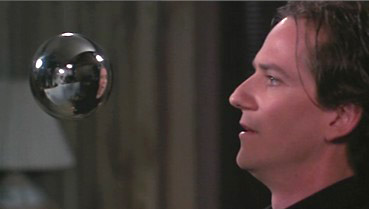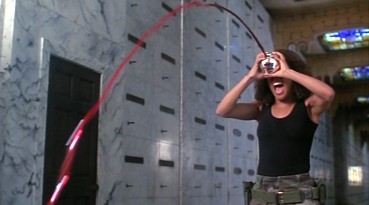Note:
This review does assume you have seen Phantasm and Phantasm II – if you haven't, then it's worth doing so before proceeding, as there are spoilers for both of those films ahead and discussion on characters and plot points established there.
When
a cult film has multiple sequels, we usually reach a point,
somewhere around number 3 or 4 (sorry, III or IV), where
it feels almost appropriate to add a label that says 'for
fans of the series only'. It seems unlikely that too many
newcomers are going to start with III and work backwards,
but with every film you also run the risk of losing a portion
of your original core audience that just doesn't like where
you're now taking something they once loved. It can happen to
the best of films and film-makers – witness the general
reaction to the much maligned
The Godfather, Part III (and I'm definitely with the crowd on that one). There
is also the perceived cheapening effect of multiple sequels,
with overlong film franchises being the butt of many a movie
joke, the general opinion being that if you get to VII or
VIII then you really are in trouble. If you want to keep
credibility for yourself and your series, get out while
you're ahead. And yeah, I'm including the Star Wars
franchise in that.
For
Don Coscarelli's Phantasm
films, III marked the point where all but the hardy seem to have deserted the series. This was not an issue of content or even execution. Few viewers frankly even got that far. For a UK audience at least, the very idea of a third film in such a horror series had a straight-to-video air, an audience perception formed by a weariness of tawdry sequels to 70s and 80s classics like Friday 13th, Nightmare
on Elm Street and Halloween. It's thus nice to have the opportunity to
properly evaluate the third and fourth Phantasm
films, packaged together so nicely as they are by Anchor Bay.

As
with Phantasm II,
Phantasm III picks up the story where its predecessor ended. Once again, this
requires a couple of minor cheats of the sort found in 'to
be continued' movie serials of years past, where you saw the lead character plunging to his death at the end
of one episode and a week later watched him jumping clear
of the car before it made its fatal, over-the-cliff dive,
and you just KNOW he was in that bloody vehicle when it plunged
to earth the week before. The Phantasm
series has never been so explicit, but at the end of each
film the clear suggestion is that although the characters
believe they have defeated the Tall Man and escaped with
their lives, he always comes back in the final seconds and
gets them. Yet come the next film it turns out he didn't
completely get them, and they are thus able to struggle to their
feet, break free of their captor, and continue the fight.
This is precisely what happens here. Reggie wasn't killed, just bashed about
a bit, and Mike is OK because the car he was yanked through
the rear window of mysteriously explodes just up the road,
throwing him some distance but leaving him dazed and essentially undamaged. Telepathic girlfriend Liz is not quite so fortunate, and has her face eaten off by a gaggle of dangerous dwarfs.
When Reggie arrives on the scene, he quickly recovers his
treasured four-barrel shotgun (which he threw away in the
previous film but which has made its way back to further
delight the fans) and starts sorting the creatures out (including
an amusing shoot-in-the-air gag). But he soon finds himself
surrounded by more of them and a newly restored Tall Man, whom
he forces to retreat by threatening to blow himself and
Mike up.
The expansion of ideas and action movie structure that distinguished
Phantasm II clearly signaled that Coscarelli
intends to give each film its own specific feel, and
the first clues regarding where Phantasm III will head are supplied right here. We've been led to believe up
to this point in the series that although The Tall Man (who
has really beefed up the telekinetic powers he discovered
in part II) enjoys what he calls "the game," his
only real interest in Mike is in killing him. Now it seems
that it's not so simple – he wants him alive. Uh-oh. This
set off warning bells for someone who lets out a dismayed scream when a sequel reveals that X is actually
the son of Y or the brother of Z, and that everything that
has happened up until now is the result not of chance but
destiny. I'll never forgive George Lucas for starting the trend
for that crap. Thus this implication, however slight, of
a special relationship between Mike and his Tall nemesis
got me twitching. Never mind, store that for later and move on.
Then
we get to my second issue, Mike's brother Jody. Yep, we
know Jody is dead, and although there is no twist that claims he survived the fatal car crash and has actually been in hiding
for all these years, having him appear in almost spiritual
form as a sort of guardian angel is actually worse, moving
us further from the science fiction of the
first film and towards a more religious reading, something
we caught an early whiff of in Phantasm II. For many
fans, this did not appear to pose a serious problem, the view being that it built
on the strong relationship between Mike and Jody that was
at the centre of the first story. But for this more cynical viewer, this narrative shift
from the physical to the metaphysical can't help but dilute
the threat by abstracting it further from the real world.

As
with Phantasm II, Coscarelli switches pace
on us and throws a few curve balls along the way. Having
Michael Baldwin (now A. Michael Baldwin) return as Mike
must have whetted fan appetites, but he's not conscious
for too long before he's kidnapped by The Tall Man and effectively
drops out of the story for some time, leaving
Reggie, at last, to take centre stage. His cross-countryside
hunt for Mike moves at a surprisingly unhurried pace,
and is disrupted by a series of encounters with others on the way.
These include three murderous looters, who kidnap him but
are then slaughtered in a dark flipside of Home
Alone's improvised house defence rigged by young
Tim, a kind of Rambo-ised replacement for the first film's
younger Mike but without his charisma, nervous energy or
screen presence. Completing the ramshackle team is Rocky, a black female ex-army girl with a fondness for nunchakus who expands
the film's potential demographic and provides a new object
of lust for Reggie's loins. At the same time, though, she
kicks against generic expectations by being tougher than
all the guys and never giving in to Reggie's pestering –
the only way he can get intimate with her is in a Nightmare
on Elm Street and Dreamscape influenced
unconscious world, where he is interrupted by Jody and more
pressing tasks.
Characterisations
aside, there are plenty of familiar touchstones here, some
coming across almost as obligatory ingredients, as with the sphere that drills
a forehead or the car chase that ends in a flip and explosion (it is a good one, though). Inevitably, there
is further expansion of themes and ideas, with a peek into the the inside
of the spheres suggesting that they are miniature
flying Daleks, a brain encased in a fighting machine (a
similarity emphasised by the eye-on-a-stalk appendage on
some of them), a concept that is reversed for murderous
drones that have golden spheres embedded in their heads.
Whether
it all works is a matter of taste, of course, but for my
money Phantasm III misses as often as it
hits. But it does intermittently hit, and sometimes with considerable style.
Perhaps the biggest surprise, though, is that just for once
the low budget starts to show in a really negative way – the corridor
to a white light Heaven has too clearly been constructed
from draped sheeting (you can see the creases), and the
vast army of spheres that turn up later, a potentially terrifying
concept, is rendered almost silly by their resemblance to
a case-load of Christmas baubles wobbling in the wind.
Anamorphic
1.85:1, the third of the series should logically look even
better than its predecessor by way of being younger, but
is in fact the weakest transfer so far. It's still pretty
good, with sharpness, colour and contrast respectable, but
the black levels tend to wander a bit, and darker scenes
lack the punch they had in the first film.
Similarly,
the soundtracks – Dolby 2.0, 5.1 and DTS, though perfectly
good, lack the bowel-trembling wallop of those on parts
I and II. They're good,
but not outstanding.
As
with all of the disks in this set we get a Commentary
Track, this time from returning actor A. Michael
Baldwin and a very tall Angus Scrimm. It's a quite lively,
anecdote-peppered chat, though Baldwin does come across
as a tad cynical and takes the piss in places, being also occasionally critical of his own performance – "I
sound like William Shatner on a bad day," he says of
one scene. Scrimm appears to know the name of every actor
who has ever appeared in even the smallest part in a Phantasm
film, and we do learn that he's a huge fan of zombie movies.
The
Theatrical Trailer (1:11) is
4:3 and has a rather peculiar stereo mix with Trailer Voice
Man emerging from the left speaker only, a little disconcerting
if your speakers are widely spaced.
Photo
Gallery consists of 10 iffy quality frame
grabs and 3 stills of marketing artwork.
The
usual Biographies pretty much
repeat those found on the disk for the first film, plus
Chris Chontyn.
It's
not great but it's not bad – the shift in pace is interesting
but the metaphysical drift doesn't work so well for me.
Fans will probably argue over this one more than they did
number II (though not as much as they did over part IV),
while non-fans will probably find little to convert the
here. The disk does the job without showing off in any way,
the main plus being the commentary which, though also not
one of the series' best, has its moments. And so to Phantasm
IV...
|